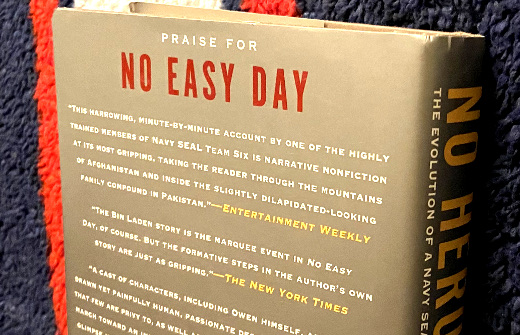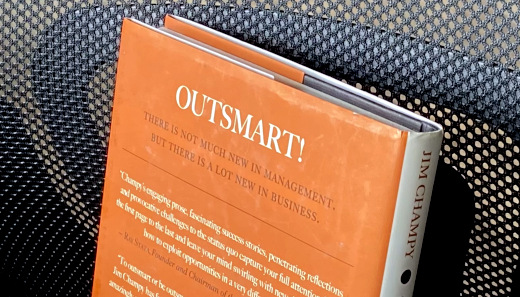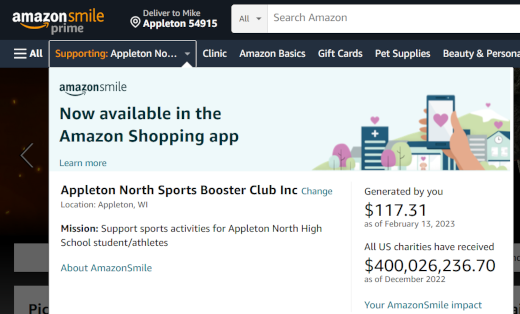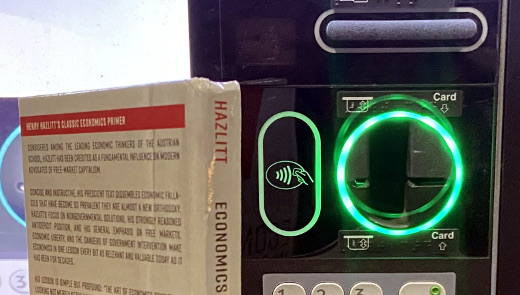My Takeaways from No Hero

A statement commonly said by Americans when meeting someone who is or has served in the military is, “thank you for your service.” As much as it is said with respect, to me it seems to barely scratch the surface of the commitment, intense training and sacrifice of those who volunteer for a branch of the military. After reading No Hero: The Evolution of a Navy SEAL by Mark Owen, that feeling was only amplified.
Owen is the pen name for a member of U.S. Navy SEAL Team Six that was part of the mission that killed Osama bin Laden. No Hero is a follow-up to his first book, No Easy Day: The Firsthand Account of the Mission that Killed Osama bin Laden, and it tells his life story from his initial interest in being a SEAL to numerous missions around the globe. It was given to me by my “brother-from-another-mother” in response to a phrase he used that I have never heard before. This phrase is among the takeaways I had from this book.
Assess, Prioritize, Act – The book gets into detail of the grueling training designed to weed out those who are not SEAL material. In one such training Owen was in a dark room with a hood over his face and when it was removed he had to react to neutralize the situation all the while surviving. He was taught to assess the entire situation, prioritize it and act accordingly – all within mere seconds. Where most of us are not in life and death situations in our daily lives, this approach to problem solving is one I try to remember when an issue arises. Try is the key word there.
After Action Review – Abbreviated as AAR, it is a report written after a mission with contributions by everyone involved. It is designed to be an honest assessment of what worked and what did not, as well as be shared with other SEALs as a learning tool. In general business, a similar term used is “post-mortem” but they are usually comprised of a meeting where people go around the conference room table and talk of similar wins and losses, but not with the same honesty as an AAR. In the Agile/Scrum world, a retrospective at the end of a sprint is supposed to bring out similar facts and sentiments and is perhaps a little more true than a post-mortem. Where these events try to mirror an AAR, true lessons learned and improvements based on them are needed throughout all worlds.
Three-Foot World – This term was the catalyst for me getting and reading No Hero. One day I was talking with my friend and he said he is trying to control his three-foot world to which I responsed, what world? It comes from a training exercise that Owen participated in where he was free climbing a rock face in the Las Vegas desert. When concerned with falling, his instructor told him to only be concerned with his three-foot world, and make sure he had control of what was in front of him and to forget about how high he was up and falling down. The phrase really resonated with me, and when in the quagmire of my daily work and life I have to focus on my three-foot world and try to control what I truly am able to. Try is the key word there too. Needless to say it is a work in process.
The concept of the Three-Foot World also got me reading more about it beyond this book. Where I found several articles about it, there was no central site on it – no threefootworld.com. Now there is, as I registered the domain name and it is pointing to this very post. I reserve the right to write more on the topic, perhaps once I master it myself.
No Hero is a no holds barred story of the emotions and actions take in war and other conflicts that America has been immersed in recent years. When you read all that goes into what makes a SEAL and what they have to endure in battles, it is thought provoking. I recommend this book to everyone. As I give all my books away, I am sharing this with a friend who is a regular reader of this humble blog whom I believe will truly appreciate this story.
This is from The Hot Iron, a journal on business and technology by Mike Maddaloni.
Did you enjoy this? Subscribe to The Hot Iron by RSS/XML feed or Read by Email
Book Take-Aways • (0) Comments • PermalinkBreaking A Work Promise To Myself

As the passing of the first third of the year is upon us, I am already breaking one of the 2 promises I made to myself at the beginning of 2023 regarding how I work. It was not a resolution, rather a small behavioral change for me to be more efficient and perhaps even more effective.
That promise was to not take any paper notes and only record things digitally.
Literally Getting Out of Hand
The genesis for this move was an ongoing pile of papers – some small Post-Its, others full notebook pages – that was becoming a bottleneck to reviewing discussions and even completing tasks. I would always have some form of paper at hand to scribble notes and manage priorities throughout the workday. I often found that taking notes by hand was more efficient in being active in meetings, an idea that has been reinforced by other colleagues and articles I have read.
For the most part this cutting out paper worked for me. I would still occasionally print a draft of a document for editing, but after applying those changes to the document file I’d promptly recycle the paper. Several times I consciously stopped myself from trying to write something down, a reaction I was able to curb by simply not carrying a notebook or paper with me. The notes I captured would go directly into my Microsoft OneNote file, which is where the written notes would eventually go as well.
Over time, there was one piece of paper I found that I needed to go back to keeping alongside me throughout the day – my personal dashboard. This is a landscape piece of paper, printed from an Excel file, with columns for projects or areas that I am working on and rows for high-level tasks or issues for each. It’s not a task list per se, rather something I refer to have everything I or my team are working on available at a glance. Thus the term dashboard applies well.
My current dashboard has 7 columns, with the last one being for “personal and professional growth.” It had 6 columns the other day, but as another project came to fruition it warranted its own column. As I am working on multiple projects with my goal to focus blocks of time on one thing at a time and avoid multitasking (as much as I can), the dashboard is a reminder of all else going on in my world.
A Break or a Bend?
Talking with some colleagues about this, there was doubt from them I was actually breaking a promise and instead bending it. To stop consuming paper was not the catalyst of this decision, but it was a nice by-product. However I consider it a break, and until I have a different system – or less going on at once – the dashboard will remain with me as I find it effective.
What was that other promise I made you may be asking? To stop asking people to turn on their cameras in work online meetings! By now, if people don’t want their camera on or realize the benefits to work culture, who am I change their minds? I have also been guilty of not having my own on as much as I used to, especially when I am the only person who turns their camera on for a meeting.
Deconstructing Breaking Promises
Looking back on my earlier decision, where I am somewhat disappointed I was not able to carry through with promise, it has certainly not broken me. Reevaluating earlier decisions or what we do is something we should actually take time out for rather than it be solely reactive and come from frustration or other emotions.
This is from The Hot Iron, a journal on business and technology by Mike Maddaloni.
Did you enjoy this? Subscribe to The Hot Iron by RSS/XML feed or Read by Email
Business • Strategize • Technology • (2) Comments • PermalinkMy Takeaways From Outsmart

Working hard versus working smart. Some will say you have to do both at the same time, others say it’s an either or proposition. I have often viewed it as a pendulum that was weighted towards working hard, but knowing when to work smart is the challenge that requires literal balance and perspective.
In the book Outsmart!: How to Do What Your Competitors, Jim Champy tells the tales of several businesses and how, around a certain period of time, they were able to rise and outsmart their competitors in various ways. That period of time was the 2000’s, as this book was written in 2008. With that in mind going into reading it, would I have takeaways from it? Yes, and several.
Outsider perspective helps – The majority of the businesses highlighted featured leaders who came into it – the business itself or the industry – as an outsider, namely someone who didn’t grow up in that line of business. Taking a new idea or what was there, they were able to look at it differently than others from within and outside and were able to thrive.
You can change how people think by changing what they do – This quote was related to the story about MinuteClinic, and is one I can personally attest to. Whether a change of venue, responsibility or assignments, doing something different – whether it’s directly aligned with your interests or not – can change your opinion greatly.
Outsourcing not always the answer and more about cost saving than quality – Attributed to one of the owners of S. A. Robotics, it justifies how the firm kept most of its work internal and did not outsource. I agree with this, and I also add the element of time to this, as outsourcing can deliver something much later and with less quality, especially if the focus is on a reduced price.
The business world in 2008 – This book was published before the recession in 2008, and a follow-on to how these business are today, if they are still in business, would be interesting to read. The story of gun manufacturer Smith & Wesson was of high interest to me, as I grew up a few miles from their headquarters in Massachusetts, one that is being relocated to Tennessee due to a changing political climate towards guns in the Bay State. Where Shutterfly was revolutionary back in the mid-2000’s, it would be interesting to see how they compare to others in that space today.
The catalyst for me reading this book was its author himself. Jim Champy was the chairman and CEO of CSC Index, a management consulting firm that was a sister firm to where I was working early in my career. He is most known for, along with Mike Hammer, pioneering the concept of Business Reengineering that swept the corporate world in the 1990’s. When I saw this book, though our paths never crossed I was compelled nonetheless to read about my, um, colleague.Outsmart is a short but good read that shows by example how strategizing and execution of that strategy can make a difference for a business. If you’re looking for inspiration to change and rise above where you are with your business, I recommend this book. As for whom I am giving it to, it’s on its way to my friend John Wall, an avid reader of this humble blog and the co-host of the long-running and best marketing podcast out there, Marketing Over Coffee. Why? Check out his recent episode where he talks about Jibbitz, who is one of the businesses featured in this book.
This is from The Hot Iron, a journal on business and technology by Mike Maddaloni.
Did you enjoy this? Subscribe to The Hot Iron by RSS/XML feed or Read by Email
Book Take-Aways • (0) Comments • PermalinkAmazonSmile Shuts Down To The Dismay of Many

On February 20, 2023 and with little fanfare, the AmazonSmile program officially shut down.
For some of you reading this, you may be saying, “really, they shut it down? I had no idea!” For others, you are saying, “what the heck was AmazonSmile?” Allow me to respond to both camps mixed with my opinion of this move.
What it was
Back in 2013, the retail behemoth introduced the AmazonSmile program as a way of giving to charities supported by their customers. For every purchase made by a customer who signed up for the program and visited Amazon with a special link, 0.5% of every purchase of items eligible for AmazonSmile went to a charity who is enrolled in the program.
Those 2 previous sentences are packed with conditions that must have been met for a charity to earn that percentage. First, you the consumer had to sign-up for the program as well as navigate to the link smile.amazon.com – yes, you had to do this, as any purchases made at www.amazon.com would not count. Really. Of course that navigating was done in a Web browser (e.g. Safari, Chrome) and early on purchases made with their mobile app didn’t count. These alone led to many of my purchases not counting towards my contribution.
A charity must also enroll in the program, as you couldn’t just designate the Mike Maddaloni Society of Reflection and Coffee as your charity. Once an organization was accepted, you could choose them as the destination for your half-percent of purchases. You could also change charities at will, as I have done over time. Originally I had my kiddos first school as they were an early adopter of AmazonSmile, but when we moved, I chose their new school. On top of this, there were occasional items that didn’t qualify towards AmazonSmile contributions; I never looked into why this was, as I only saw it infrequently as I shopped their platform.
Why shut it down?
I first heard about the shutdown in a roundabout way, and with some searching I found this official announcement on Amazon’s corporate blog. Interestingly, I never received an email on this, but I digress. In smaller circles I saw news stories on it, such as this article from the Associated Press that quoted Amazon spokespeople as well as charities impacted by this. But by and large, this passing went by without much attention.
I’ll let you read both of those linked stories above, but I will share my interpretation of what happened. A quote from an Amazon spokesperson said they were making a “strategic shift” and those 2 words also pack a lot. First off, Amazon doesn’t need a program like this – after the lockdowns over the past few years, people’s shopping habits have moved more and more virtual with Amazon being a major beneficiary of this. With their recent layoff announcements, they and many other companies are cutting back and an assumption that they are cutting this simply to reduce overhead costs isn’t an unfair assumption. Plus a CEO handing a giant Happy Gilmore-style check to an equally giant charity makes for better public relations than an anonymous check arriving in the mailbox of a needy charity. Blend in global inflation and recession and all of this is only amplified.
Define impact
Learning about this a mere few days before the program closed and disappeared from their Web site, I decided to take a look at my own impact, which you can see in the screenshot below:

As you can see, in the almost half decade I was using AmazonSmile, my family and I helped raise a whopping $117.51 for charities. Not a lot, eh? But again we are merely one shopping family with the previously-mentioned caveats.
Another way to look at this is in a glass half full way; as AmazonSmile is going away, enter local distribution centers and delivery in your area and the jobs that come with this. Though to some charities it may be a slap in the face to see an Amazon truck driving through a neighborhood that is losing a quarterly charity donation from its owner. Where one economic door closes, another opens.
Speaking of economics, one way to express your disappointment with this move by Amazon is to shop elsewhere. Granted the convenience of throwing things into your cart and ordering whenever is not to be dismissed, but many of the items you are shopping for may be available in local stores you likely have forgotten about. Check them out – you may be pleasantly surprised.
How do you feel about AmazonSmile’s departure? I welcome your comments to this blog post at thehotiron.com.
This is from The Hot Iron, a journal on business and technology by Mike Maddaloni.
Did you enjoy this? Subscribe to The Hot Iron by RSS/XML feed or Read by Email
Business • Strategize • (0) Comments • PermalinkMy Takeaways From Economics In One Lesson

Economics. When you hear that word, what do you think? For some, it's a view of the world and how it operates. For others, they simply ignore it. For myself, as aware as I like to be of what happens in and around me, the topics of economics was always a fragmented one.
Taking Economics 101 in college didn't help things. It may have been a combination of things, including the nickname for my professor being "shaky" which was related to his hand gestures, how much alcohol he reportedly drank and likely both. The constantly exploding red pens in his shirt pockets was another distraction. I will never forget when he typed tests on a manual typewriter, he simply backspaced and put a slash thru mistakes and kept typing. Though these are no excuses, all my memories from that class are non-academic.
When I learned about a book called Economics in One Lesson by Henry Hazlitt, I had to check it out. Both being "one" lesson and being free were enticing to me. The book was offered by the Mises Institute, a libertarian think tank, and I took them up on their offer to receive a printed copy of the book, an offer unfortunately is no longer available. Hazlitt, a libertarian author, originally wrote the book in 1946 and it was revised and extended in 1979. As libertarians (and I am grossly summarizing here) believe in very small government and free markets, I was interested in what I learn from the text, as some of my own world views are in line with this thinking.
As I read through the pages of Economics in One Lesson, it helped me structure the bits and pieces of economics I have collected over the years, and I had several takeaways from it.
Simple examples – To setup what I was about to learn, in the early pages of the book was a hypothetical story of a store keeper who was saving for a new suit but had to spend the money on a new window when one in his shop was broken. As a result there was no net benefit to economy – the window glazer made out but the tailor did not, and neither did the store keeper for that matter. Stories like this and others help set the stage and drive home concepts throughout the book.
Global view – Hazlitt states that to truly study an economic impact you must trace both short and long term impacts and impacts on a special group and everyone impacted by it. He gave examples of laws and decisions made by governments that benefit one group at the expense of another, and that impact may be long after the decision is made and executed upon.
So what is Credit? – A statement that stuck out to me is regarding credit, that is something we already have not something a lender gives us. Granted if I walked into any bank and said that they would laugh at me and want to see my FICO score, but it is something I recall whenever the topic of credit comes up.
Economic Sybil – The idea that we have multiple economic personalities was something I hadn’t thought about. Some of those include being a producer, taxpayer and consumer, and the thinking around each will have some common and uncommon components.
Economics in One Lesson was an enjoyable read, something I wasn’t expecting for a book on this topic. It was written in a way to educate without shaming and didn’t pretend to be the one and only book you should read on economics, as in the end there were suggestions for further study. Where the offer to get this book for free no longer exists, I recommend picking up a copy if you are interested in learning or brushing up on economics. For the giveaway of this book, it is going to stay in the house for now as my lovely wife is interested in brushing up on what she learned here and abroad in economics.
This is from The Hot Iron, a journal on business and technology by Mike Maddaloni.
Did you enjoy this? Subscribe to The Hot Iron by RSS/XML feed or Read by Email
Book Take-Aways • (0) Comments • Permalink
